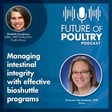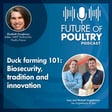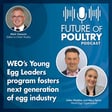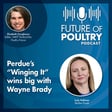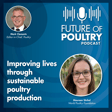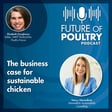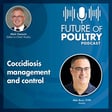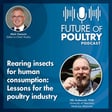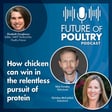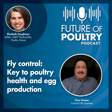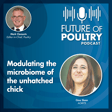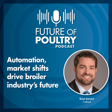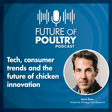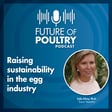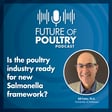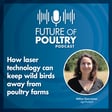Become a Creator today!Start creating today - Share your story with the world!
Start for free
00:00:00
00:00:01

Putting Salmonella control under the microscope
Take a look at the key strategies to keep Salmonella at bay throughout the poultry production chain in this episode of WATT Poultry Podcast featuring Marcos Rostagno, DVM, Ph.D., U.S. technical and innovation director with Trouw Nutrition, and Mark Clements, editor-in-chief poultry, with WATT Global Media.
Transcript
Introduction to the Podcast Series
00:00:00
Speaker
Hello and welcome to the Future of Poultry podcast series.
00:00:12
Speaker
Hello, I'm Mark Clements, Editor-in-Chief Poultry with WhatGlobalMedia.
Salmonella Control Discussion with Dr. Marcos Rostano
00:00:16
Speaker
On today's edition of the Future of Poultry podcast, we're putting salmonella under the microscope, or to be more precise, its control.
00:00:23
Speaker
And to do that, I'm joined by Dr. Marcos Rostano, US Technical and Innovation Director with Trow Nutrition. Marcos, welcome to the Future Poultry podcast.
Why is Salmonella a Global Challenge?
00:00:33
Speaker
Thank you for having me. It's a pleasure to join you today for this chat.
00:00:37
Speaker
Marcus, much of the industry has been working on salmonella reduction for decades and there are numerous control programs. So why does salmonella remain a consistent challenge for producers around the globe?
00:00:51
Speaker
Well, that's a good question, right? It's a challenge, a persistent challenge if for the whole industry. Anywhere you go, you will hear about some now. I think some key factors that lead to that persistence of the challenge or difficulty on eliminating this challenge is that commercial production systems were not developed microbial contaminations in mind.
00:01:14
Speaker
They were developed with a process in mind and in terms of raising animals, large number of animals in the most efficient way.
00:01:25
Speaker
So there are a lot of opportunities for microorganisms to persist and thrive in any production system, right? is not ah completely it's not like you have these chickens in a closed room, completely sterile or anything.
00:01:38
Speaker
There are a lot of multiple or diverse entry points for any pathogen to get in.
Complexities of Salmonella Control
00:01:44
Speaker
I think also on the other hand, we have to understand that we think about salmonella as a single pathogen or a single entity, and it's not. It's a very complex group and a very large group of pathogens. There are more than 2,500 salmonella serovores, and they are very different from each other.
00:02:06
Speaker
that Not only general characteristics, but the way they survive, the way they multiply, their ability to infect the host. So all this creates complexity.
00:02:16
Speaker
And I think my third point that I always bring up and that when people ask about this difficulty that we have with this pathogen is, fortunately, most of our colleagues working in this area really don't realize how limited our measurement tools are or What we look at, what we think is a problem, it's actually a lot of noise. So there is a lot of confusion or confoundings as well in any salmonella monitoring control program. So all these things combine the system, the measurement tools or the monitoring tools, plus the complexity of the pathogen makes it really hard to effectively control it.
Regional Differences in Salmonella Control
00:02:55
Speaker
Salmonella remains the leading cause of foodborne zoonotic illnesses, leading to hundreds of thousands of vitalities each year. And within Europe and the US alone, salmonellosis leads to billions in losses, meaning that there's still a clear need to axe.
00:03:10
Speaker
But there is no one-size-fits-all approach. Guidelines and practices still differ from region to region. Yeah, I think you're a spot on, right? There is no one size fits all, or what I also call the magic bullet.
00:03:24
Speaker
We tend to, everybody we visit or we talk to, they want to, hey, what i can't what can I do to solve my salmonella problem? They always look for that little trick, right? Oh, give me something or tell me something, a little secret.
00:03:37
Speaker
And it doesn't exist. So different countries, different areas of the world assign different priorities or different weight for the challenge of salmonella. We look at Europe. Salmonella someone else has been in the top of mind problem for decades.
00:03:55
Speaker
Then you look at North and South America. yeah it's there, but it's not faced the same way as Europe. And then you have Asia and Africa, where really is not their top concern unless someone is exporting.
00:04:09
Speaker
And then they have to ah follow the global standards. But with all that said, the approaches are different because of what we just discussed on the topic before. There's so much room for different approaches, different ways of looking and facing this challenge that it generates different approaches. So EU, for instance, for many years, focused heavily on pre-harvest of breeders and the animals instead of the post-harvest.
00:04:36
Speaker
In the US and other countries, they tended to focus more on the post-harvest side. So all these have value. I don't think one or the other is the correct or wrong. yeah yeah It's a combination.
00:04:48
Speaker
But also there is another component is the availability of intervention tools. Some products, some feed additives or even vaccines or things like that and not available everywhere in the world the same way. So that creates another layer of differences in how you look
Integrated Approach to Salmonella Control
00:05:06
Speaker
it.
00:05:06
Speaker
All these leads to different programs, different ways of managing what I call the risk in different countries, different regions, which leads to different programs and areas of focus that vary significantly between different countries, production systems, and so forth.
00:05:23
Speaker
So with so many variables, what would be a good starting point for developing a salmonella control program? That's a good question and common one that we get is, and what I tell people is that salmonella, a control strategy for salmonella has to be very comprehensive and very integrated.
00:05:41
Speaker
It has to consider a variety of critical points or risks or checkpoints across the whole production chain. And when I talk about production chain, it's not just...
00:05:53
Speaker
pre-harvest, post-harvest. It goes all the way back from breeders, feed mills, production, post-harvest, and so forth. So there are so many opportunities for contaminations or recontaminations that many different pathways are possible on this.
00:06:12
Speaker
So again, there is no magic bullet. There is no magic solution. So it requires a long and broad perspective when you do this, but it needs to be, you need to really first step is understand in all this complexity where your system sits in.
00:06:29
Speaker
What are your main points of entry? What are your main points of risk? And what I tell people, focus on the risk and then as a consequence, you hit Salmonella.
00:06:40
Speaker
So could you just give us preps? A few key points that that we should check. I think you mentioned feet mills. Are there perhaps four or five points where we really need to be checking?
00:06:52
Speaker
Yeah, well, was as I mentioned, and it's a recurring topic to bring up when you talk salmonella, complexity, right? A lot of risk points or critical checkpoints. There are many, many along the chain as you study each system, and it varies by production system. The company A has the structure their systems in one way.
00:07:12
Speaker
Company B has a different structure or the way they manage. So that's why it's a case-by-case scenario. But there are always, I would say, two key or most consistent sources of contamination.
00:07:27
Speaker
which are the two main inputs that come into your system, which are the checks and the fee, or it's raw materials or feedstuff or ingredients you're going to use.
00:07:38
Speaker
These are by far the two main entry points. There are many others, but in terms of impact, these are what I call continuous input inputs.
00:07:50
Speaker
points because you have an inflow consistently. Every day you bring chicks for new house. you Every day you bring feed for and every single house.
00:08:01
Speaker
And it's constantly these two are, I would say, the key points that have to be paid
Farm-Level Salmonella Control Strategies
00:08:07
Speaker
attention to. But like things basic things like detailed cleaning, hygiene and biosecurity are extremely important. They are the ones that minimize even if you have salmonella coming into your system.
00:08:20
Speaker
These are little things that help maintain the dissemination or the contamination or the recontamination at very low levels. Then you have other things like but you have to look at how you look at estimation. You have to understand your system.
00:08:36
Speaker
How do you look at your data? How you collect this data? How you interpret this data to make decisions and see how you go. And then if you move beyond in that, you go all the way to the processing or post-harvest, which is a whole different chain in itself.
00:08:53
Speaker
But ah that's what I mean with this brief summary. When I talk about a comprehensive and integrated approach to control salmonella. ah you You mentioned salmonella risk in raw materials.
00:09:07
Speaker
Should that be the starting point for control? And i'd like to know, do different raw materials present different risks? Definitely, yes. Every point is critical, of course, but you have to start with the raw materials that you include in the feed. they are The continuous input you bring to make feed is all the raw materials. And of course, some of them are in high volumes and constantly being brought in.
00:09:31
Speaker
It's difficult to to separate or keep them separated by batches and so forth. So you have to start with what I call the microbial quality of your raw materials. We tend to focus a lot in terms of nutritional, chemical ah aspects of these ingredients or raw materials, but we sometimes miss the microbial quality.
00:09:54
Speaker
quality of it. On top of that, you have different materials representing different levels of risk. For instance, you look at surveys done all over the world, you can see consistently the most common raw materials or ingredients associated with salmonella contamination are usually protein sources, right? Of course, if you have any animal source, fish, meat, meal, whatever, there are much higher risk.
00:10:21
Speaker
But even the common ones, soybean meals or things like this, you often find them or frequently contaminated with salmonella. And here, a key point that I like to make is It's an analogy that I made to do when help people visualize this is yeah there is the same toxicology, right? What makes the poison is the dose.
00:10:43
Speaker
I say, yeah, what makes the risk here is the amount, the volumes. So even if you have a low frequency, value frequency but you do have... certain frequency of salmonella contamination.
00:10:55
Speaker
The high volumes of these materials that you bring into your feed mill every single day and it goes through your system, that's what creates the risk and creates the problem of contaminating your feed. At the mill, where should we pay particular attention to prevent contamination?
00:11:14
Speaker
So something that most feed meals in the world miss is being more strict on the microbial quality of that raw material ingredient. Testing, separating batches, making sure you allocate them based on microbial quality. I know that's logistically a nightmare.
00:11:34
Speaker
As again, the system from the feed meal, production, anything, They were not developed with microbial conditions in mind. They were developed to move things quickly, efficiently through the system, right? the Inputs, outputs without a lot of interruptions, separations, or things like that. So that, over time, will have to change.
00:11:58
Speaker
But it's difficult once you have a fixed structure, a physical structure like a feed meal system. invested in, you pay millions, you build that, to change that is not easy.
00:12:09
Speaker
But slowly companies have to start thinking long term and think about that. But along the manufacturing process, you have multiple points. One that I like to call attention to is the pelleting and the post-palleting, the cooling of the feed. Everybody tends to think on pelleting as the magic bullet. Oh, high temperature, quickly, we eliminate contaminations. We tell them there is variation there. the That temperature, and the time to reach that temperature, sometimes you'll have gaps. On top of that, equipments get old, they get overused, and then you start having problems with consistency or stability of the process. So I've seen a lot of feed meals
00:12:53
Speaker
with issues in palatine conditions, which allow for contaminations to go through, or even recontaminations to happen in the cooling afterwards, because it then it creates condensation. You have problems with humidity and microorganisms, salmonella, they love ah water, they love humidity.
00:13:13
Speaker
So that creates a lot of problems sometimes, even if your palatine conditions are perfect and you kill the bacteria, you control everything, The moisture is afterwards or because of this condensation, the cooling process may create blind spots for contaminations.
00:13:30
Speaker
And people also be happy after that forgets of taking note of the storage. After you make all this feed, spend a lot of money, control risk.
Sampling, Lab Analysis, and Risks
00:13:40
Speaker
How about the bins or the silos where you're going to keep this feed and then the whole distribution of these feed to farms and so forth. But there are just an example here of some key points that are oftentimes missed in salmonella control programs in the feed meal.
00:13:56
Speaker
If we move now to the farm, what would be the essentials there for salmonella control? Beyond what we just discussed and a few points that I highlighted, at the farm, what is under your control, of course, is Stress of the animals is very important.
00:14:15
Speaker
Density, events that cause stress are very important, right? So those are important. Why? Because animals will tend to have consequences to that stress.
00:14:28
Speaker
And that helps salmonella. Back in a previous life, I did a lot of research on effects of stress on microbial populations in the gut, and it's been shown over and over again how stress favors some anemone in the intestinal tract of the animals.
00:14:44
Speaker
Then you have also the immune system. So those are basic things. Then you have the biosecurity, which I already touched heavily, especially in terms of limiting access of other birds, of wild birds, other animal species, traffic of people, equipment, trucks, right ah hygiene, cleaning, disinfection.
00:15:07
Speaker
And then you have the intervention tools like via water, via feed. what There are a lot of tools, for instance, organic acids, blends of organic acids are well known in the industry and widely used.
00:15:19
Speaker
But that's when you have to know your problems to know which one you need. for what time, what specific stage in your production system, which again brings me to the point of a case-by-case scenario. You have to understand what you're dealing with. You have to understand your problem to really plan an effective solution.
00:15:40
Speaker
And then, of course, more recently, the use of vaccines. But again, I would like to highlight all these different things that I just touched quickly. We could develop entire presentations in each one of them are not magic bullets. This is a whole comprehensive program that you need multiple of these steps to be effective to to succeed.
00:16:04
Speaker
With sampling procedures, why is it important to consider those and the capabilities of the lab where the samples might be analyzed? This is a very interesting area that a lot of people miss. And what I tell them is everybody knows that the old say, if you don't measure, you can't manage it or...
00:16:25
Speaker
You can't manage it if you don't measure. And I tell people, I'll add a little bit more detail to that. If you don't know how or what you're measuring or understand what you're measuring, you won't be able to manage it correctly.
00:16:39
Speaker
So a little, a few points I touched quickly, but a little... ah attention that I call to people is that first you have to understand the dynamics of Salmonella along the whole poultry production processing chain.
00:16:51
Speaker
That's crucial. If you don't understand that dynamics, it becomes very difficult to really design a good sampling program, identify the key points you have to keep track or keep an eye on.
00:17:05
Speaker
It's complex, but it's not complicated. That's what I tell people. But that's the challenge. Unfortunately, a lot of people in the industry don't understand it. They think it's a very static linear system and it's not.
00:17:19
Speaker
ah There a lot of variables and factors that play into that. Second is there is no perfect sampling program. I tell people if you want 100% effective or precise sampling, it's 100% samples, but you can't do that. You can't sample every bird, every house, every day.
00:17:39
Speaker
It's impossible. That's why it's costly and nobody will do it and physically impossible to do. When you do a sample, it implies in a margin of error right there.
00:17:50
Speaker
And then you add to that the lab that will receive and analyze those samples. i How well trained, how efficient is this lab? Do they know what they're doing?
00:18:01
Speaker
And on top of that, different techniques that different labs use have different levels of sensitivity. i The basics of diagnostics is sensitivity, specificity.
00:18:13
Speaker
Each method is different. So you start compounding all this. your marginal error is really high. So that's why I said you need to understand these factors to really know and interpret that data. And i unfortunately, people take those, oh, we have X ah frequency this week.
00:18:33
Speaker
Oh, it went X plus something next week. Oh, it's increasing. Someone else will have a problem. You have to apply correct methodology to interpret print and analyze that data set so you know when to intervene and where.
00:18:47
Speaker
That is a big challenge. If we now turn to the slaughterhouse, what would be some of the contamination risks that we ought to consider there? As I mentioned sometime before, is the post-harvest or slaughterhouse or processing different regions, call it different ways.
00:19:05
Speaker
It's what I call after you produce those birds. There is ah an in-between that I tell people is a limbo. I did a lot of research in that area many years ago. It's between the farm and the plant.
00:19:18
Speaker
So it's transporting these animals, holding these animals before ah entering the processing facility. All these have has a very strong impact in the microbial population, salmonella in itself, rapid infection. So a lot happens in those populations.
00:19:34
Speaker
I would say 10 to 12 hours that between the farm and the plant that a lot of people don't realize that affects what happens at the plant. Why? Because now getting specific at the plant, it's a different type of environment, right?
00:19:50
Speaker
When we are at the at the plant, you have ah High volume lines with high speed, a lot of animals going through that really quick, in each hour, not even the days, each hour.
00:20:04
Speaker
so there is ah it' So it's an environment which I call conducive to persistent and dissemination of pathogens like salmonella. Why? Because there's a lot of water in it.
00:20:15
Speaker
Remember, and as water, humidity, which Salmonella loves. There are a lot of splashes, there are a lot of aerosols, there is a lot of handling machinery, stretching multiple carcasses or pieces of the animals through the whole process.
00:20:30
Speaker
So cross-contamination or fresh contaminations It's something top of mind when you think in processing in in the post-harvest.
00:20:41
Speaker
So that those are key points where you have to really pay a lot of attention, a lot of people, a lot of labor, a lot of individuals, a lot of machines, and all these conditions that I just mentioned.
00:20:54
Speaker
So that's why there is a lot of of quality control programs. or HACCP programs that used at the plant, which follow pretty much the same mindset that I just described at the farm. And I like to use that as an analogy to when I talk to producers, I say, think about what everything you do at the plant.
00:21:13
Speaker
It's the same approach you have to do at the farm, at the feed, meal, breeding, and so forth. Critical control points, interventions in each one of them to minimize
Collaboration for Effective Control
00:21:24
Speaker
risk.
00:21:24
Speaker
Could you share with us, with your customers, what advice do you offer them for managing risk across all these checkpoints? I think collaboration is critical. As I mentioned, we have multiple sections of these long complex chain.
00:21:40
Speaker
So you're going to have multiple teams, each one of them focusing in a different space, different area or different link of this chain. So collaboration is crucial. So that leads to when I talk collaboration, two key points, right? Communication and engagement.
00:21:56
Speaker
When I talk about communication engagements, what I tell people, it's across the whole chain at all levels. Upper management is not just the worker in the field, in the processing line, in the truck.
00:22:10
Speaker
No, it's every other level up. Directors, big bosses, CEOs, the general management, they need to understand what is being done. They need to understand if they want to see results and they need to support that because it requires investment, time, focus, dedication.
00:22:30
Speaker
So work and that's another piece that I usually bring up is working with an external party helps a lot. And I think it's very important. The most successful experiences I've seen always involve an external party.
00:22:44
Speaker
Why? People say, well I don't need, I have a lot of... people, experts in quality. The challenge for them is they fall in their day-to-day routine. So it's very easy to miss things, details, when you are doing the same thing over and over again.
00:23:00
Speaker
That's when fresh pair of eyes, someone that comes from the outside, from times to validate, check things, make sure nothing's missed, helps. They come to a different perspective.
00:23:11
Speaker
On top of that, you they bring different experiences. They usually deal with multiple systems. As a back to our point, and there is a case by case.
00:23:22
Speaker
There is no one size fits all. It's because each system is different. But the more experience you get in different production systems, you identify the best interventions, the best approaches for each one of these factors, right, or critical points. So that is very important.
00:23:39
Speaker
And that's what we try to do, develop expertise so we can support our customers, right? Working with multiple companies, multiple customers across the globe. That's what we try to do. And many other companies do as what are trying to do as well.
00:23:53
Speaker
So this is what I think is important. Communication, collaboration, engagement, that and help from outside sources always are very valuable to customers. Absolutely. Marcus, what would be the most important message you hope listeners will take away from our conversation today?
Final Thoughts on Salmonella Control
00:24:10
Speaker
I think some key points, if I can recall from my my all everything I just explained, I know it's a bombardment of information. As I said, each topic can be developed in its own discussion.
00:24:23
Speaker
But I would say first and foremost is Salmonella challenge is complex, yes, but it's not complicated. You need to have a good understanding. It requires, again, what I just said, engagement.
00:24:37
Speaker
collaboration, communication, commitment. Use the resources that your suppliers or consultants or whoever you can use as external fresh pair of eyes that can help and share that experience has a different view.
00:24:52
Speaker
can What I say is they're not going to replace your team. They're going to guide your team and where they should focus, what to do and be more efficient and detail that. And I think the top message that I tell because I roll my eyes every time I hear that is there is no magic bullet.
00:25:11
Speaker
There is no one size fits all. So it requires a comprehensive time to really see results, understand what you're dealing with, and consistency to be able to really face this stout challenge.
00:25:27
Speaker
If it was easy and there was a magic bullet, I tell people there wouldn't be salmonella. We wouldn't be talking about it right now because it would have been solved already. Marcus, thank you so much for joining us today.
00:25:39
Speaker
I appreciate the opportunity. I hope I was able to bring some valuable insights to your audience, to the customers and everything. And always glad to help and share our experiences.
00:25:51
Speaker
Listeners, very many thanks to you for joining us. You can find more information about Salmonella on whatpoultry.com. And don't forget to look out for upcoming editions of the Future of Poultry podcast.
00:26:05
Speaker
Goodbye.

